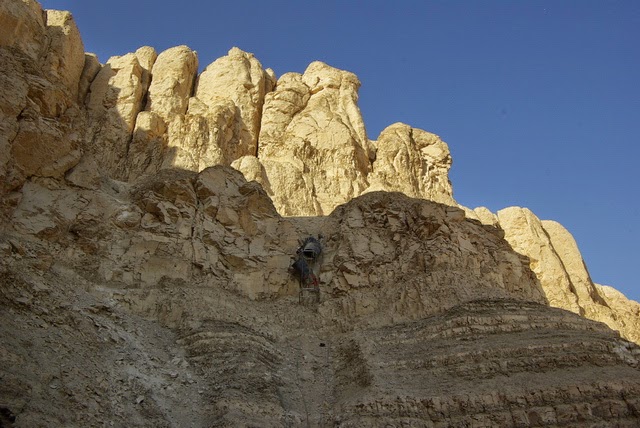Preliminary report on the results of the works done by the Polish Cliff Mission at Deir el-Bahari: October–December 2014
The Polish Cliff Mission have begun the works on the 18th October, and continued these until the 11th December. The staff of the Mission consisted of: Egyptologists: Andrzej Niwinski (the director), Kamil Zachert (the deputy director) and Weronika Bronowska, engineers and technicians: Waldemar Kubiczek, Wojciech Fraszczynski and Dariusz Flajszer, as well as the photographer Slawomir Malinowski. The SCA Inpector was Sayed Ali Sayed Gomaa.
The most of the time of the works has been devoted to the removal of the stones and debris from the central part of the site, situated directly above the ruins of the temple of Thutmosis III [Fig. 1]. This accumulation of the stones, and especially the weak retaining wall were always dangerous to the temple area [Fig. 2]. The quick progress of the works made possible the complete removal of this [Fig. 3]. The surface of the rock was systematically cleaned, which revealed numerous traces of the ancient engineering works, especially having in purpose a protection of the tectonic fissures there [Fig. 4]. In two spots the tomb shafts were evidently begun, however never finished [Fig. 5].
In the last days of the season, the preparatory works have been started to change the place of the installation used by us for the safe removal of stones and debris [Fig. 6]. The new situation of the upper part of the installation (the place of the lower part will not be changed), about 40 m to the south from the corner of the temple of Thutmosis, is intended to remove stones of the old redim, which may create, in case of an earthquake, a threat to the area of the temple of Mentuhotep Nebhepetre [Fig. 7]. The operation of the removal of this is previewed for the next season, probably in January-February 2015.
Prof. Andrzej Niwiński
Fig. 1
Fig. 2
The most of the time of the works has been devoted to the removal of the stones and debris from the central part of the site, situated directly above the ruins of the temple of Thutmosis III [Fig. 1]. This accumulation of the stones, and especially the weak retaining wall were always dangerous to the temple area [Fig. 2]. The quick progress of the works made possible the complete removal of this [Fig. 3]. The surface of the rock was systematically cleaned, which revealed numerous traces of the ancient engineering works, especially having in purpose a protection of the tectonic fissures there [Fig. 4]. In two spots the tomb shafts were evidently begun, however never finished [Fig. 5].
Fig. 3
Fig. 4
Fig. 5
In the last days of the season, the preparatory works have been started to change the place of the installation used by us for the safe removal of stones and debris [Fig. 6]. The new situation of the upper part of the installation (the place of the lower part will not be changed), about 40 m to the south from the corner of the temple of Thutmosis, is intended to remove stones of the old redim, which may create, in case of an earthquake, a threat to the area of the temple of Mentuhotep Nebhepetre [Fig. 7]. The operation of the removal of this is previewed for the next season, probably in January-February 2015.
Fig. 6
Fig. 7 (all photos by Kamil Zachert)
Prof. Andrzej Niwiński









Komentarze
Prześlij komentarz